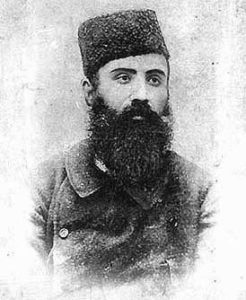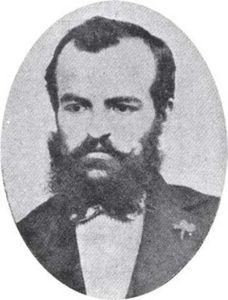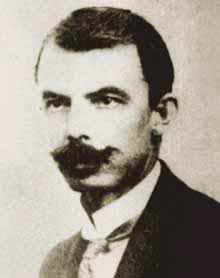Macedonian progressive forces were thriving in the 90-ties of XIX century. The political activities against the Ottoman Empire were spontaneously increasing, as well as against foreign propaganda in Macedonia. This resulted in the formation of the revolutionary organization called TMORO (The Secret Macedonian-Odrian Revolutionary Organization) on 23rd October 1893 in Thessalonica.
The First Committee of TMORO for Ohrid was set up in August 1894. Its first members, and at the same time the leaders, were Lev Ognenov, Gorgi Nikolov, Nikola S. Filipcev, and Aleksandar Cakarov. Later on A. Keckarov joined the Organization. According to his records, in the period between 1896 and 1900 Hristo Uzunov, Metodij Patce, Kiril Prlicev, Luka and Ivan Grupcev, Klime Zarov, Atanas Kanevce, Andreja Hristov, Boris Proevski, and others, joined the Organization as members or as supporters. The first action of the Organization was the assassination of Dimitrija Grdanov who was incriminated for subversion of the national and political unity of the masses. He was shot by M. Patcev. Ivan Nelcinov, Naum Atanasov-Cvetinov, Naum Cakarov, Naum Zlatarov, and Spiro Sargov joined the Organization in the third development phase of the Committee. Also, Nikola Petrov Rusinski and several other commanders of military groups who fought for freedom joined in. Under direct leadership of these people, the Ohrid region was preparing to join the Ilinden Insurrection.
More prominent figures of this period were Hristo Uzunov and Metodij Patcev. Uzunov was the ideological leader of the revolutionary movement in the Ohrid region. His father was a teacher who was actively involved in the revolutionary movement, and also his mother who belonged to a family of the Revival activist Gorgi Cakalov from Struga. Patcev became the commander of the region of Prilep in the fall of 1901. There, in a relatively short time, his enormous abilities were put into action. However, he was surrounded by a large number of Turkish troops in the village Kadino Selo in the region of Prilep on 6th April 1902. He, and his seven soldiers resisted for two days, but eventually they decided to kill themselves heroically.
The First military group of TMORO in the region of Ohrid was established relatively late. The main reason for this was the lack military professionals. In spring 1901, a number of Macedonians who worked abroad returned to their country. Amongst them were Dejan Dimitrov, Milos Bogdanov and Miladin Golev. They decided to set up a military group in the monastery St. Petka in the village Velgosti and Tale Goranov from Prilep was elected Commander. A few prominent organizers from Ohrid must be mentioned: Dejan Dimitrov, a farmer born in the village Laktinje who spent some time working abroad, also Smile Vojdanov, from the same village, then Nikola Mitrov from the village Elsani, as well as Tasko Arsov, and Tase Hristov. Goranov proved to be destructive as a Commander and he was replaced by Nikola Petrov Rusinski.
In the years that preceded the Ilinden Insurrection, the Organization paid special attention to the awakening of the national awareness of the peasants, improvement of living conditions, and at the same time supplied arms to the people. On the Congress that took place in Smilevo it was recorded that the region of Ohrid was the best-armed region in the Bitola district. The Organization communicated the message that the local population must have mutual understanding and tolerance. These issues were the source of disputes that made Commander Rusinski leave the region of Ohrid. Namely, the local population, encouraged by some of the leading figures in the Organization, started to express national hatred for the local Turkish population. Commander Nikola Petrov Rusinski could not understand that and left the region in 1902.
After Rusinski left the military groups were restructured. The county was divided into five sectors. Each sector had one military group under the leadership of the following commanders: priest Hristo from village Velgosti, as well as Smile Vojdanov, Dejan Dimitrov, Luka Grupcev, and Tase Hristov. An additional squad was formed, commanded by the teacher Argir Marinov (Marince).
In March 1903, due to the recklessness of the Commanders Davidov and Dimitrov, a major breakthrough shook 17 villages in the region of Debarca. After the battles, 218 members of the Organization were imprisoned by the Turks. The prisoners were taken to Dijar Bekkhir in Asia Minor via Ohrid, Bitola, and Thessalonica. It was not until the Ilinden Insurrection was over that they were amnestied, but only a hundred of the prisoners returned to their homeland.
During the Thessalonica (January) Congress of the Organization in 1903, a decision was made to commence with the uprising. The County Congress took place in village Smilevo 1st May 1903. There the Ohrid Commander Hristo Uzunov, leader of the delegation from the Ohrid Revolutionary County, suggested postponement of the Insurrection due to insufficient organization and lack of arms. However, his suggestion was not accepted.
Before the Insurrection, the Ohrid Revolutionary Organization was divided into five sectors according to the terrain configuration. The first sector was the Drimkol sector, while the second was the sector of Malesija (Both near Struga). The third sector was Debarca with the mountains Karaorman, Koparnica, and Plakenska (with Commanders Smile Vojdanov and Dejan Dimitrov). The fourth was the sector of Orta Kol, an area located between the Ohrid Plain and Debarca, whose Commander was Argir Marinov (Marince). The fifth sector was Lake Region (the area around the eastern shore of Lake Ohrid), with Commander Nikola Mitrev-Ezerski.
According to preserved documents, it is obvious that the actions were well elaborated. The whole military action was planned in 14 action points. A decision was made to start the Insurrection on 2nd August, Ilinden (a religious holiday). Battles continued throughout the region during the entire month of August (except for Ohrid that served as a base for supplying fighters). The Turks burned down all villages that came into their way, except for Brezani and Plake.
Among the many battles, the largest one was near the village of Rasanec. The revolutionists suffered major defeat, after which the Insurrection came to an end. Several commanders were killed in this battle, among whom were Argir Marinov (Marince), Andon Uzunov (the brother of H. Uzunov), Hristo Parmakov, Naum Zlatarev, Lazar Stefanov, Stefan Kurtelov, Lambo the Barber, and many others.
Overall, 31 battles took place in the Ohrid region during the Insurrection.
2091 uprisers fought against 45898 Turkish soldiers. The ration of the forces was 1:22. During the battles 118 rebels and 374 Turkish soldiers were killed. From the 75 villages involved in the Insurrection, 32 were burnt to ashes, and 10 of them were partially burnt. Two thousand and sixty four houses were burnt and more than 13,000 people were left homeless. The villages of the Debarca region suffered the most during the Insurrection. Out of 22 villages only 4 were not burnt down.
Ohrid played a significant role during the Insurrection. Apart from the fact that it was designated to provide food for the uprisers, Ohrid was the place where a hospital was planned to be built. The town teachers Poliksena Maksinova, Kata Samargieva, Fance Suleva, Hrisanti Maskareva, Czareva Botuskova, Atina Sehova, Flora Georgieva, Despina Vasilceva, Flora Miteva, Elena Kackova, and Aspasia Miseva decided to organize and set up a hospital. After working on it for three weeks, the hospital was handed over to the English Mission and it continued to work.
Those who visited Ohrid in the period after the Insurrection came to the conclusion that Ohrid was neglected, only occasional remnants of its celebrated past still existed, and the town people were exhausted and fell into deep misery and fear. The social and economic situation in the region of Ohrid deteriorated. As a result, during the first decade of the XX century, a great number of Macedonians went to America searching for a job. One record shows that in 1907 alone 3,639 citizens of Ohrid went to America hoping to find a job.
Immediately after the Ilinden Insurrection, the famous Murzteg Reforms were implemented by the powerful countries. Bearing in mind the requests of the people from Ohrid, Russia and Austria-Hungary drafted a project for reestablishing the Ohrid Archiepiscopate, together with its archpriest synod and other ecclesiastical bodies in late 1903. The project provided for the introduction of the Macedonian language in the religious services and schools. The Turkish authorities rejected the project. However, they were forced to give their consent to Hilmi Pasha to implement the project and separate the Macedonian eparchies from the Exarchate and Patriarchate. This was opposed by all neighbouring countries. At the same time, the Russian Czar and the King of England designed a project for an autonomous Macedonia, but that project also failed.
After the Ilinden Insurrection, the majority of the Commanders left Ohrid and went to Sofia, including: Andon Keckarov, Naum Anastasov, Aleksandar Cakarov, Luka Grupcev, Marko Pavlov, Lazar Dimitrov, Dejan Dimitrov, and Smile Vojdanov. Their leaving left a bad impression on the people. Commander Hristo Uzunov spent some time on the Mountain Smilevska in the region of Ohrid, and then returned to his County in December 1903 in order to reestablish the abolished Committees of the Organization. During 1904 and 1905 Uzunov mainly focused at resisting the existing foreign influence, and at resolving the ideological and theoretical problems that the Organization was facing with.
In March 1905 Uzunov went to Bitola, and after that in the region of Krusevo in order to inspect the territories. On 24th April in the village Czer (Kicevo region), Uzunov and the Commander of Krusevo, Vanco Srbakov, were surrounded by a great number of Turkish troops. Nobody helped the rebels and they were forced either to surrender or to kill themselves. Before deciding for the latter, Hristo Uzunov wrote his last letter in which, among the other things, he wrote the following: “My last piece of advice to all my companions is to be sincere to our cause and to everyone who serve that cause, because only chastity and pure sincerity raised the Internal Organization, and they solely will save it from the abnormal situation it has been placed into by our companions who have a distorted awareness. Please do your best to destroy, as soon as possible, those people within the present leadership of the Organization that have harmed the cause, those like Sarafov, and do not punish mere workers. Our idea will be accomplished…”
After he wrote the letter and handed over the entire archives, the Commander and his 11 companions killed themselves.
The revolutionary activity of the Organization continued in spite of the numerous breakthroughs. The man who helped in resolving the problems in Ohrid was Petar Caulev. He did that by using his organizational and military skills. He was also a fair revolutionary judge, because the local population was advised to avoid the Turkish courts and to resolve their disputes through the national revolutionary courts.
In July 1907, on the mountain Slatina in the Ohrid region the Congress of the Bitola Revolutionary sector of VMRO (Internal Macedonian Revolutionary Organization) took place. It was hosted by the citizens of Ohrid and lead by the Commander P. Caulev. He, with several military groups, was responsible for the security during the Congress. After the Congress there is no evidence of any major activity of the Organization. The military groups continued to operate until the beginning of the Young Turk Revolution, when the majority of them were legalized.

Virtual Macedonia
Republic of Macedonia Home Page
Here at Virtual Macedonia, we love everything about our country, Republic of Macedonia. We focus on topics relating to travel to Macedonia, Macedonian history, Macedonian Language, Macedonian Culture. Our goal is to help people learn more about the "Jewel of the Balkans- Macedonia" - See more at our About Us page.
Leave a comment || Signup for email || Facebook |
History || Culture || Travel || Politics

















